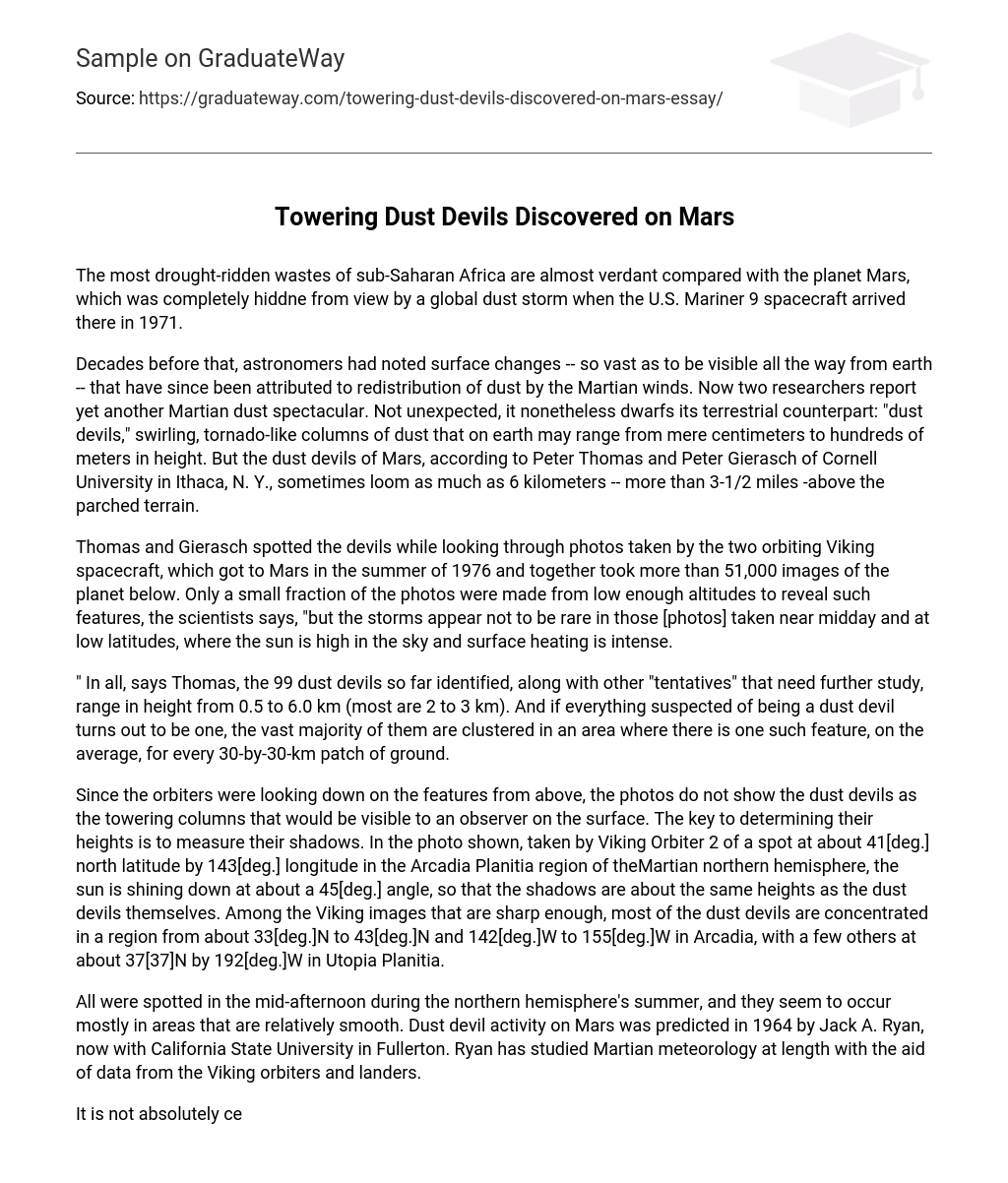The most drought-ridden wastes of sub-Saharan Africa are almost verdant compared with the planet Mars, which was completely hiddne from view by a global dust storm when the U.S. Mariner 9 spacecraft arrived there in 1971.
Decades before that, astronomers had noted surface changes — so vast as to be visible all the way from earth — that have since been attributed to redistribution of dust by the Martian winds. Now two researchers report yet another Martian dust spectacular. Not unexpected, it nonetheless dwarfs its terrestrial counterpart: “dust devils,” swirling, tornado-like columns of dust that on earth may range from mere centimeters to hundreds of meters in height. But the dust devils of Mars, according to Peter Thomas and Peter Gierasch of Cornell University in Ithaca, N. Y., sometimes loom as much as 6 kilometers — more than 3-1/2 miles -above the parched terrain.
Thomas and Gierasch spotted the devils while looking through photos taken by the two orbiting Viking spacecraft, which got to Mars in the summer of 1976 and together took more than 51,000 images of the planet below. Only a small fraction of the photos were made from low enough altitudes to reveal such features, the scientists says, “but the storms appear not to be rare in those [photos] taken near midday and at low latitudes, where the sun is high in the sky and surface heating is intense.
” In all, says Thomas, the 99 dust devils so far identified, along with other “tentatives” that need further study, range in height from 0.5 to 6.0 km (most are 2 to 3 km). And if everything suspected of being a dust devil turns out to be one, the vast majority of them are clustered in an area where there is one such feature, on the average, for every 30-by-30-km patch of ground.
Since the orbiters were looking down on the features from above, the photos do not show the dust devils as the towering columns that would be visible to an observer on the surface. The key to determining their heights is to measure their shadows. In the photo shown, taken by Viking Orbiter 2 of a spot at about 41[deg.] north latitude by 143[deg.] longitude in the Arcadia Planitia region of theMartian northern hemisphere, the sun is shining down at about a 45[deg.] angle, so that the shadows are about the same heights as the dust devils themselves. Among the Viking images that are sharp enough, most of the dust devils are concentrated in a region from about 33[deg.]N to 43[deg.]N and 142[deg.]W to 155[deg.]W in Arcadia, with a few others at about 37[37]N by 192[deg.]W in Utopia Planitia.
All were spotted in the mid-afternoon during the northern hemisphere’s summer, and they seem to occur mostly in areas that are relatively smooth. Dust devil activity on Mars was predicted in 1964 by Jack A. Ryan, now with California State University in Fullerton. Ryan has studied Martian meteorology at length with the aid of data from the Viking orbiters and landers.
It is not absolutely certain that the features in the images represent true, rotating dust devils, but, says Ryan, “they certainly have all the appearance we would expect to see.” The possibility is also consistent with Ryan’s finding that a number of vortices — the same kind of swirling winds that can sometimes pick up loose particles to form dust devils — have crossed over the wind speed and direction sensors of the Viking landers.
As for whether such spinning winds actually pick up enough surface material to form visible dust devils, he notes, that depends on such factors as temperature, the amount of available loose surface grains, the size of the grains and the cohesion between them. Could the photographed features be volcanic plumes, which would be a momentous and unexpected finding? They cannot be ruled out, admits Gierasch, but he says there is no evidence from other Viking instruments (such as the spectrometers aboard the orbiters) of the trace gases that would accompany such activity, and the surface around the features appears unisturbed.
Furthermore, the Cornell researchers noted at the recent Lunar and Planetary Science Conference in Houston, Mars lacks the bountiful water that is constantly modifying the surface of the earth. On Mars, according to the researchers, wind transport of dust is “the major process that changes the face of the planet.”





